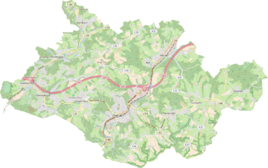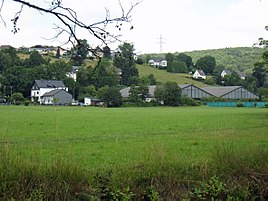Daubenbüchel
|
Daubenbüchel
City of Overath
Coordinates: 50 ° 56 ′ 37 ″ N , 7 ° 12 ′ 26 ″ E
|
||
|---|---|---|
| Height : | 96 m above sea level NN | |
|
Location of Daubenbüchel in Overath |
||
|
Sülzaue with Daubenbüchel (foreground),
in the background houses on the Brüderstraße |
||
Daubenbüchel is a district of Untereschbach in the town of Overath in the Rheinisch-Bergisches Kreis in North Rhine-Westphalia , Germany .
location
Daubenbüchel is located in the far west of Overath on the state road 284, which leads from Rösrath to Lindlar , here is called Hoffnungsthaler Straße. Nearby are the villages of Unterauel , Mittelauel , Großbuchholz and the abandoned Grünewald mine .
history
The name refers to the Daubenbüchel family farm. In old writings, a Wilhelm Daubenbüchel is first mentioned, who in 1665 was already 95 years old.
The Topographia Ducatus Montani by Erich Philipp Ploennies , Blatt Amt Porz , shows that the residential area had two farmsteads as early as 1715, which are labeled as Dam̅enböggel . From the chart of the Duchy of Berg from 1789 by Carl Friedrich von Wiebeking it emerges that the local area was part of the Lower Church Game Immekeppel in the Bensberg Higher Court at that time .
The place was near the Brüderstraße , an important medieval old highway from Flanders via Cologne to Leipzig .
The place is shown on the topographical survey of the Rhineland from 1817 without any labeling. The Prussian first recording from 1845 shows the living space under the name Daubenbüchel . From the Prussian new admission in 1892, the place is regularly recorded as Daubenbüchel on measuring table sheets .
After the collapse of the Napoleonic administration and its replacement, the place belonged to the mayor's office of Bensberg in the Mülheim am Rhein district . The town, which was categorized as a farm estate in 1845 according to the overview of the government district of Cologne , had three residential buildings with 21 residents at that time, all of them Catholic denominations. The municipal and Gutbezirksstatistik the Rhine Province leads Daubenbüchel 1871 with four houses and 29 residents. In the municipality lexicon for the Rhineland province of 1888, three houses with 20 inhabitants are given for Daubenbüchel . In 1895 the place had three houses with 13 inhabitants and belonged denominationally to the Protestant parish Volberg and the Catholic parish Immekeppel, in 1905 three houses and 26 inhabitants are given.
On the basis of Section 10 of the Cologne Act , several Bensberg outlying areas were converted to the municipality of Overath in 1975, including the area around Untereschbach with Daubenbüchel.
Individual evidence
- ↑ Jörg Poettgen (editor): 950 years Overath (1064–2014) / Street names tell stories. Ed .: Bergischer Geschichtsverein Overath eV, Overath 2014, p. 37.
- ^ Wilhelm Fabricius : Explanations for the Historical Atlas of the Rhine Province. Second volume: The map from 1789. Division and development of the territories from 1600 to 1794. Bonn 1898.
- ^ Herbert Nicke : The Brothers Street. From the history of the old country road from Cologne to Siegen . In: Land and history between Berg, Wildenburg and South Westphalia . tape 4 . Galunder, Wiehl 2001, ISBN 3-931251-58-6 , pp. 70 ff .
- ↑ Alexander August Mützell, Leopold Krug (Ed.): New topographical-statistical-geographical dictionary of the Prussian state. First volume. A-F. With Karl August Kümmel, Halle 1821 ( digitized ).
- ↑ Royal Government of Cologne (Ed.): Overview of the constituent parts and list of all the localities and individually named properties of the government district of Cologne, according to districts, mayorships and parishes, with information on the number of people and the residential buildings, as well as the Confessions, Jurisdictions , Military and earlier country conditions. Cologne 1845 ( digitized ).
- ^ The communities and manor districts of the Rhine Province and their population. Edited and compiled by the Royal Statistical Bureau from the original materials of the general census of December 1, 1871. In: Königliches Statistisches Bureau (Hrsg.): The communities and manor districts of the Prussian state and their population. tape XI , 1874, ZDB -ID 1467523-7 ( digitized ).
- ^ Community encyclopedia for the province of Rhineland. Based on materials from the census of December 1, 1885 and other official sources, edited by the Royal Statistical Bureau. In: Royal Statistical Bureau (Hrsg.): Community encyclopedia for the Kingdom of Prussia. tape XII , 1888, ZDB -ID 1046036-6 ( digitized version ).
- ^ Community encyclopedia for the province of Rhineland. Based on materials from the census of December 1, 1895 and other official sources, edited by the Royal Statistical Bureau. In: Royal Statistical Bureau (Hrsg.): Community encyclopedia for the Kingdom of Prussia. tape XII , 1897, ZDB -ID 1046036-6 .
- ^ Community encyclopedia for the Rhine Province. Based on the materials from the census of December 1, 1905 and other official sources, edited by the Royal Prussian State Statistical Office. In: Königliches Prussisches Statistisches Landesamt (Hrsg.): Community encyclopedia for the Kingdom of Prussia. Booklet XII, 1909, ZDB -ID 1046036-6 .
- ^ The Cologne Act in full. Retrieved June 7, 2016 .


